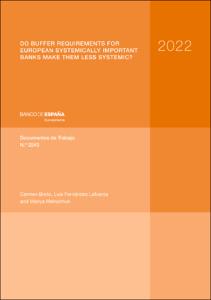Do buffer requirements for European systemically important banks make them less systemic?
Autor
Fecha de publicación
16-dic-2022
Descripción física
39 p.
Resumen
Los colchones de capital para las entidades de importancia sistémica (EIS) fueron diseñados para mitigar los riesgos que suponen estos bancos grandes y complejos. Mediante un modelo de datos de panel para una muestra de bancos europeos que cotizan en bolsa se demuestra que los requerimientos de capital para las EIS logran reducir el riesgo sistémico percibido por los mercados en relación con estas instituciones, aproximado mediante el indicador SRISK de Brownlees y Engle (2017). También se analiza el impacto de los mecanismos de ajuste que utilizan los bancos para cumplir con estos requerimientos de capital para las EIS y su contribución al riesgo sistémico. Los resultados muestran que, ante un aumento de los colchones fijados para las EIS, los bancos responden principalmente mediante aumentos de su capital, en línea con el objetivo de los reguladores. Una vez introducidas en el modelo las diferentes opciones a disposición de las EIS para cumplir con estos requerimientos y ciertas características de las entidades (como, por ejemplo, el tamaño total de sus activos), se encuentra un efecto residual por el hecho de tener el estatus de EIS. Este resultado sugiere que ser designada como EIS proporciona una señal positiva a los mercados, que hace disminuir su contribución al riesgo sistémico.
Buffers for systemically important institutions (SIIs) were designed to mitigate the risks posed by these large and complex banks. With a panel data model for a sample of listed European banks, we demonstrate that capital requirements for SIIs effectively reduce the perceived systemic risk of these institutions, which we proxy with the SRISK indicator in Brownlees and Engle (2017). We also study the impact of the adjustment mechanisms that banks use to comply with SII buffer requirements and their contribution to systemic risk. The results show that banks mainly respond to higher SII buffers by increasing their equity, as intended by the regulators. Once we control for the options SIIs employ to fulfil these requirements and SII characteristics (e.g. total asset size), we find a residual effect of having SII status. This result suggests that being an SII provides a positive signal to markets by further decreasing its contribution to systemic risk.
Buffers for systemically important institutions (SIIs) were designed to mitigate the risks posed by these large and complex banks. With a panel data model for a sample of listed European banks, we demonstrate that capital requirements for SIIs effectively reduce the perceived systemic risk of these institutions, which we proxy with the SRISK indicator in Brownlees and Engle (2017). We also study the impact of the adjustment mechanisms that banks use to comply with SII buffer requirements and their contribution to systemic risk. The results show that banks mainly respond to higher SII buffers by increasing their equity, as intended by the regulators. Once we control for the options SIIs employ to fulfil these requirements and SII characteristics (e.g. total asset size), we find a residual effect of having SII status. This result suggests that being an SII provides a positive signal to markets by further decreasing its contribution to systemic risk.
Publicado en
Documentos de Trabajo / Banco de España, 2243
Materias
Requerimientos de capital; Entidades de importancia sistémica; Riesgo sistémico; SRISK; Política macroprudencial; Capital requirements; Systemically important institutions; Systemic risk; SRISK; Macroprudential policy; Regulación y supervisión de instituciones financieras; Bancos centrales y otras autoridades monetarias; Modelización econométrica; Instituciones crediticias de depósito
Aparece en las colecciones:












